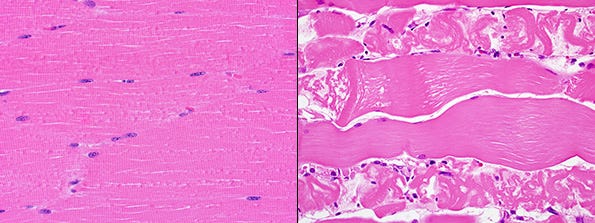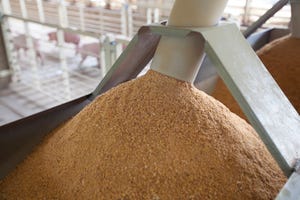The clinical signs shown by pigs intoxicated with ionophores are variable depending on the drug and the amount fed. In general, in cases of ionophore intoxication pigs are off feed, weak, depressed and don’t have a fever.
August 29, 2016

Ionophores are a group of antibiotics used as feed additives to control bacterial and coccidial infections and to promote growth in poultry, cattle and swine.
These substances are safe when administered at the right dosage and to the right animal species, but they can cause serious disease if they are fed in excess or with some other medications.
The only approved ionophore for pigs in the United States is narasin (Skycis 100, Elanco), which is used to promote the growth of finisher pigs. Narasin is also commonly used in chicken diets. Other ionophores approved for other species that have caused intoxications in swine are monensin, salinomycin, lasalocid and maduramicin (Table 1). The clinical signs shown by pigs intoxicated with ionophores are variable depending on the drug and the amount fed. In general, in cases of ionophore intoxication pigs are off feed, weak, depressed and don’t have a fever. They don’t want to stand or walk, and when forced to walk they show signs of pain (vocalization) and may be uncoordinated. Some pigs are lying down without neurological disease (no paddling or nystagmus). Some pigs may have elevated respiratory rates.
The clinical signs shown by pigs intoxicated with ionophores are variable depending on the drug and the amount fed. In general, in cases of ionophore intoxication pigs are off feed, weak, depressed and don’t have a fever. They don’t want to stand or walk, and when forced to walk they show signs of pain (vocalization) and may be uncoordinated. Some pigs are lying down without neurological disease (no paddling or nystagmus). Some pigs may have elevated respiratory rates.
It can affect 50-100% of pigs with different severity and sometimes it will affect only pigs in one particular feed line. At necropsy, pigs often do not have any apparent gross lesions. However, microscopically pigs have striking lesions in the muscles. Ionophore intoxication causes a widespread degeneration and necrosis of the myocytes, the cells in the skeletal muscle (Figure 1). Therefore, when suspecting ionophore intoxication (weak and painful pigs which are off feed with no fever and no gross lesions at necropsy) it is critical to include samples of skeletal muscle in the set of samples submitted to the laboratory for diagnosis. A sample of feed must also be sent to the lab for detection and quantification of ionophores. Introduction of new, non-medicated feed usually results in a quick response, with pigs going back to feed and recovering from the disease. However, the toxic event can result in chronic failure to thrive in the affected pigs.
Figure 1: Microscopic lesions in skeletal muscle. Left: Normal microscopic appearance of skeletal muscle, with orderly cross-striation in the myofibers. Right: Skeletal muscle from a pig with narasin toxicosis showing myofiber degeneration and necrosis, with loss of the orderly myofibers appearance and replacement by clumped, amorphous material.
There are three main causes of ionophore intoxication.
1. Errors in the rate of inclusion of narasin in swine diets expected to contain narasin. Narasin can be included in pig diets at 15-30 parts per million for growth promotion. Any errors in the feed mill that result in an excess of narasin or a bad feed mixture can lead to a toxic event. For example, an accidental overdose due to a broken load cell resulted in feed batches containing between 139 and 645 ppm of narasin. In that case 17% of the finishing pigs that received the feed either died or had to be euthanized. It is important to note that under the new Food and Drug Administration antibiotic regulations narasin is considered a “non-medically important antibiotic.” Therefore, unlike some other antibiotics currently labeled for growth promotion, this antibiotic will continue to be available for swine producers and the proportion of diets using it may increase.
2. Accidental inclusion of narasin in swine diets not expected to contain narasin, such as those which contain tiamulin (Denagard 10, Elanco). Tiamulin is an antibiotic commonly used for treatment and control of bacterial diarrhea in swine. However, tiamulin interferes with the metabolism and excretion of ionophores and can result in toxic blood levels, even if the dosage of the ionophore in the feed might otherwise be safe.
3. Inclusion of an ionophore intended for a different species in a swine diet. This is usually due to errors in feed mills that prepare feeds for multiple species. In some cases these errors result in high levels of ionophores in the swine diet that are directly toxic to pigs. In other cases, the levels of ionophores included in the swine diet may not be enough to cause the disease by themselves but toxicity arises from the combination of ionophores with tiamulin.
Ionophore intoxications are infrequent in swine. However, when they occur they result in severe intoxication affecting a large number of pigs. In addition, the relatively recent approval of narasin as a growth promotant for swine in the United States and the new antibiotic regulations coming up in 2017 may cause an increase in the frequency of ionophore intoxication cases in the future. Therefore, knowing how to recognize a potential case of intoxication and how to diagnose it is critical for an accurate diagnosis and quick implementation of control measures. Observation of the characteristic microscopic lesions in skeletal muscle and detection and quantification of ionophores in feed are essential steps for the diagnosis of ionophore intoxication.
You May Also Like



